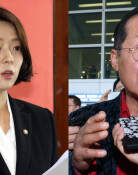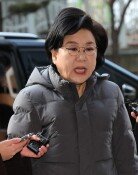Why Are General Election Exit Polls So Inaccurate?
Why Are General Election Exit Polls So Inaccurate?
Posted April. 07, 2008 05:04,
With the general elections coming up Wednesday, complaints are rising over the inaccurate results of exit polls. Survey institutions have time and time again come up with candidate prospects that prove completely off the mark when election results are announced.
Critics also cite the same problem occurred in the 2000 and 2004 elections, showing lack of improvement in survey methods and accuracy.
Survey institutions say many unpredictable variables can affect the elections depending on region, and that the results can vary according to when the survey was conducted.
○ Different results for polls and ballot counts
The Dong-A Ilbo analyzed exit polls that were conducted ahead of the 2004 general elections. The results were that in 13 constituencies where the gap between approval rates for candidates was greater than 10 percent, the results turned out to be the reverse.
A TNS poll in the Jongno ward of Seoul showed that Uri Party candidate Kim Hong-sin had an approval rating of 41.2 percent, higher than the Grand National Partys Park Jin with 11.2 percent. Park, however, won the seat with 588 more votes than Kim.
A Gallup Korea poll the same year showed that GNP candidate Hong Jun-pyo was far behind Uri Party candidate Heo In-hoi in Seouls Dongdaemun-eul district at 25.2 percent to 40.8 percent, but Hong won.
In Mokpo, South Jeolla Province, a poll by Media Research showed a lead of 16.2 percentage points for Uri Party candidate Kim Dae-jung over Democratic Party candidate Lee Sang-yeol. Kim, however, lost the election by 10.3 percentage points.
Exit poll results that came 20 days before the 2004 general elections showed an approval rating of 36.3 percent for the Democratic Partys Sohn Se-il and 27.1 percent for the GNPs Kang In-sup. But the results were the opposite, as Kang won with 43.5 percent of the vote over Sohn (37.7 percent).
○ Inaccurate network exit polls
Exit polls conducted on Election Day are also usually inaccurate. Such surveys collect answers from voters who move 100 meters from a voting booth after casting their ballots. But the results of exit polls aired at 6 p.m. on Election Day and those of the elections announced around 10 p.m. have repeatedly turned out different.
In the 2004 general elections, KBS announced at the close of voting its list of projected winners.
In Jongno, Uri Party candidate Kim Hong-sin has beaten incumbent lawmaker Park Jin. In Dongdaemun-eul, the Uri Partys Heo In-hoi has defeated GNP lawmaker Hong Jun-pyo the announcer said.
KBS said 196 candidates in 243 constituencies won their seats by margins greater than the statistical error range. But the results showed the opposite of what the networks exit polls had predicted in six constituencies.
In 13 out of 47 constituencies in which the gap between the top two candidates fell within the error range according to KBS, the approval ratings of the winner and runner-up were the opposite of what the exit poll had predicted.
KBS had projected 157 to 182 seats for the then ruling Uri Party, MBC 155 to 171 seats, and SBS 172 seats. But contrary to the prediction of an overwhelming victory, Uri managed just 152 seats, barely securing a parliamentary majority.
○ Change unlikely
The reason exit polls for the general elections are unable to accurately reflect voter sentiment is because regional factors have a strong influence, unlike in the presidential election.
Also, the error range is broader because each constituency has only about 500 samples. The presidential election covers the whole nation, but it is difficult to extract an adequate pool of samples with balanced ratios of region, age, and sex. Moreover, participation in the surveys is lower in general elections.
Korea Research Center director Kim Jeong-hye said, In general elections, voter sentiment in certain regions can even be reversed within a week. The proposition that pre-election polls should accurately predict the outcome is too big a demand.
Introduced in 1996, exit polls are also vulnerable to inaccurate prediction by system. The biggest hurdle is assessing the true thoughts of a voter who has just cast his or her ballot.
In the advanced age group, a higher percentage ignores poll staff when asked whom they voted for, though the participation rate is high. Supporters of opposition parties also tend to avoid giving answers.
As a result, exit polls have failed to detect the support of many older voters for the opposition party. In 1996, no exit poll predicted the strength of the United Liberal Democrats, and in 2000, polls underestimated the approval rate for the then opposition GNP.
If the percentage of voters who answer when asked whom they voted for turns out to be low, this would be another factor misleading exit poll results.
Choi Yeong-muk, a media and communication professor at SungKongHoe University, said, It seems unlikely that structural factors required for the accuracy of exit polls, including the adeptness of the poll staff and conditions in which the voters can express their political inclinations frankly, will be realized right away.







